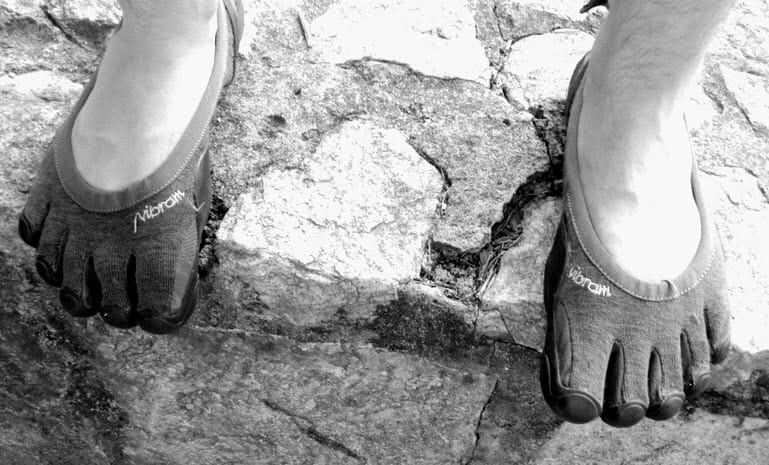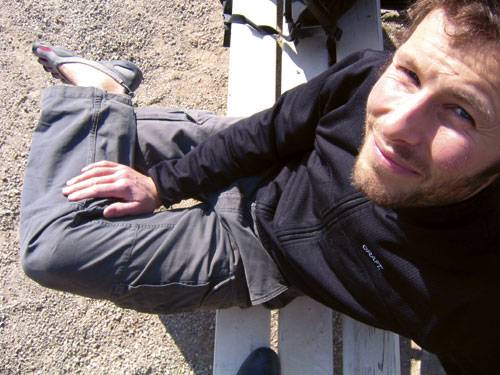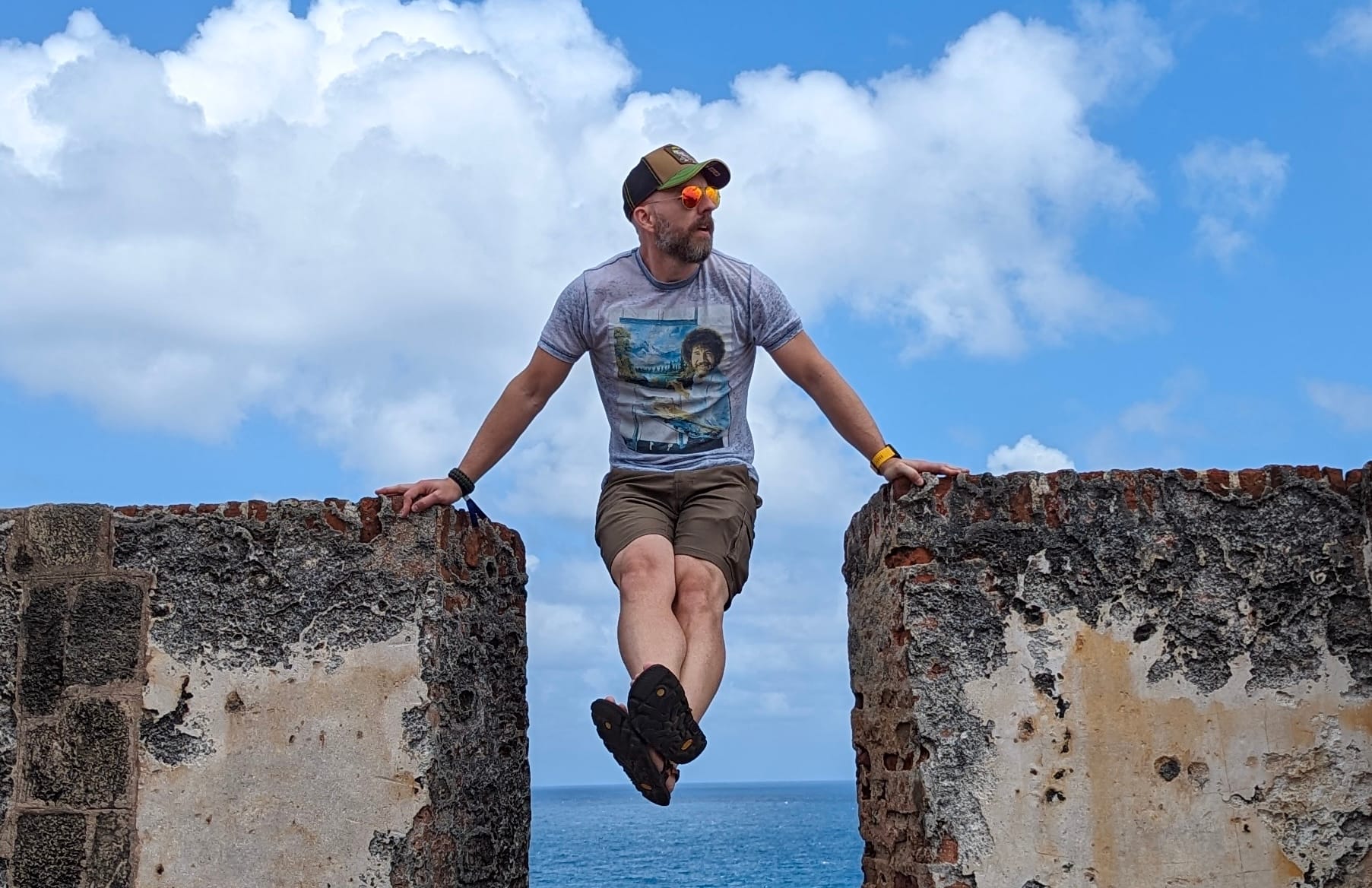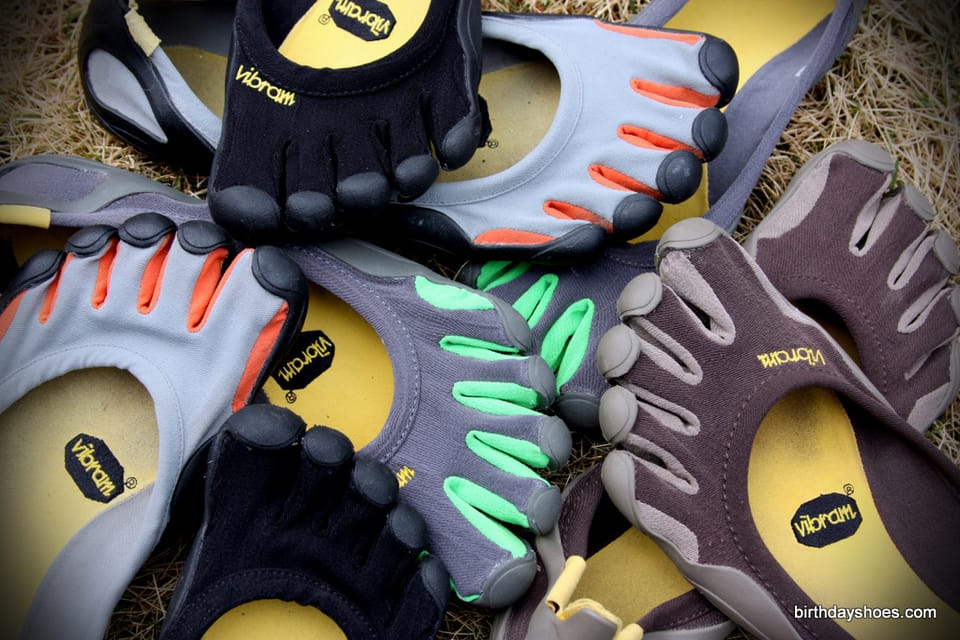This is Not a Fad: You can Run Pain Free.
Giving up on running after two decades of swollen knees and chronic injuries, one runner discovers the key to pain-free running is in how to run with a forefoot strike, as with Pose or Vibram Five Fingers.
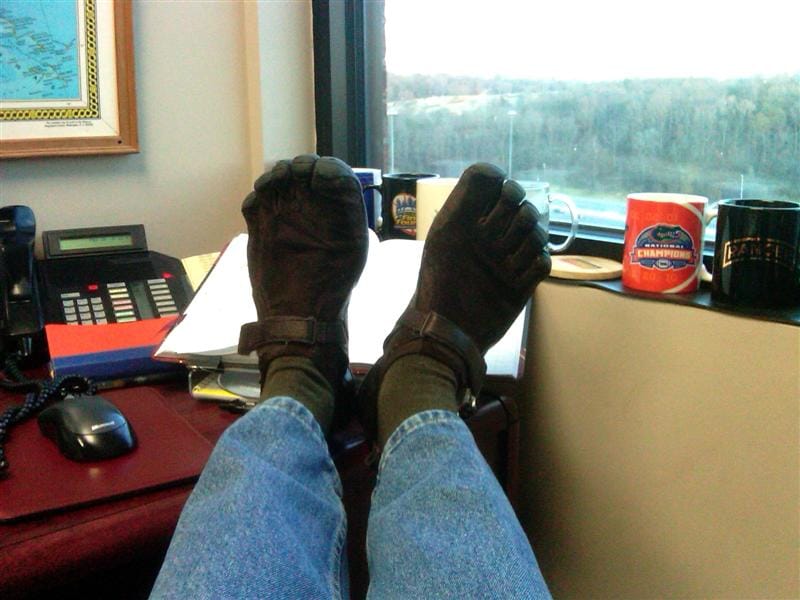
Guest post by Dave Parmly
From the design labs of Nike, Inc. to athletic shoe retailers to “fitness trainers," ripples of change are upsetting the conventional wisdom many of us grew up believing about the sport of running. New ideas have the potential to reduce running-related injuries and make the sport more accessible and enjoyable. One trendy new idea is the concept of barefoot running or “minimalist running.” Publicized in books like Born to Run by Christopher McDougall, featured in Runner’s World, Parade Magazine, Scientific American, and other media outlets, the return to our less-padded past is generating a lot of buzz.
As a father of three, I caution my family to avoid fads, “crazes,” and trends that promise much but deliver less. I’m a skeptic and I admit it. It was with skepticism that I looked at barefoot/minimalist running. I’ve been running in Army combat boots or expensive running shoes for 30 years. In my mid-20s, I was logging 6-minute miles, 60 to 75 miles a week, and running half-marathons regularly. After leaving the military, the miles dropped but I was a regular, habitual runner. Right up until five years ago, when I was forced by chronic pain to stop running completely.
A runner in pain, a runner no more ...
For 20 years, I was a runner in pain. It started at age 25, with nagging knee pain from Osgood-Schlatter disease. I kept running, but it wasn’t easy. You name it, I experienced it: plantar fasciitis, shin splints, and knees that swelled after a run, and sounded like sand paper with every stair step. I just popped Ranger M&Ms (Motrin), laced ‘em up and went back out. Many of you share my addiction, the call of the road. At 40, I went to a running specialist, got videoed, measured, and coached. I changed my stride, bought new shoes every 500 to 600 miles, tried rubberized tracks and springy treadmills. Sometimes it improved, but always the behind-the-knee swelling, not painful, indicated something wasn’t right. Finally, when the swelling persisted for days, not hours, after even a short treadmill run, I knew I had to stop. So at age 45, right as my metabolism was settling in for retirement, I took away the only regular exercise I knew.
An ex-Army buddy turned me on to CrossFit, a general fitness concept that does not emphasize distance running. CrossFit worked my metabolism, built strength, and got me back in shape. But when the Workout of the Day (the "WOD") called for any distance running at all, I substituted something else. I was off the running market for good, I thought.
A fortuitous "pose" — rediscovering running
One evening I watched an online lecture clip about “POSE Running,” a style of running that completely removed the shin/knee/hip strain inflicted by most conventional running styles, which are permissible only because of the heavily padded shoes most people wear. POSE running emphasizes shorter strides and landing on the forefoot, with the body kept vertical over the feet and hips.
The coach in the video demonstrated the pounding the heels sustain as our running mass lands on that bone at the back of the foot. No matter how much you pad it, no matter how often you change your running shoes, when you run with a heel-strike your heels are hammered by forces they were not designed to sustain. Only modern running shoes, with their heavily padded heels permit this ultimately self-destructive running style.
One evening, while walking the dog, I decided to see if I could try a little of this POSE running. I was wearing old, split at the sides New Balance cross trainers. I only went for a little 1/8 mile jog, coming down on my forefoot, keeping my heel off the ground. I slowed to a walk, a little winded. “Wow, that really does strain the calf,” I thought. Forty-eight hours later delayed onset muscle soreness ("DOMS") caught me. Yow! My calves were tight as drums. Still, I noticed none of the knee swelling I used to get after even the shortest run. Interesting. After a few days, I took the dog out again and tried the same running style, but ran a little longer, maybe a 1/4 mile this time. A little less soreness in the calves but no knee pain or swelling.
After that, I went to the internet to learn all I could about forefoot running, POSE technique, and the advantages it offers to runners of all types. After some weeks of warming up and gradually increasing distances, I was back, a runner once again.
I rarely ran more than three miles, and a 10 minute-mile is my plodding pace. But I was running. And it didn’t matter that I ran in old, broken down New Balances. The forefoot strike and the arch of the foot provided all the padding I needed. But I was running pain-free for the first time in 24 years. I was a believer.
Still, I looked at my shoes and noted a lot of unneeded rubber and nylon. I dug deeper into “back to the basics” running and found the concept of barefoot running (BFR) and minimalist running (MR). The idea is simple: run with nothing on our feet except what we were born with, or as close to that as possible, eschewing the padding, heel cups, wicking fabrics, micro chips and laces. The runner lands lightly on the forefoot and quickly pulls the foot high off the ground so it can descend down, landing under the hips, cushioning the strike with the wonderful mechanical function in the arched foot of homo erectus.
In Born to Run Christopher McDougall describes the physiological characteristics of humans, apart from all species, to run for long distances. McDougall states that we are made to operate efficiently without “running shoes” and did so for a long time. He notes that Roger Bannister broke the 4-minute mile in shoes that resembled ballet slippers, with no heel or any padding. Bannister was also injury free his whole running career.
Discovering the barefoot alternative — Vibram Five Fingers
One day, while browsing through my favorite adult toy store, River Sports Outfitters on Sutherland, I noticed an odd-looking combination of a glove and a shoe. The sales associate said “Oh, those are called the Vibram Five Fingers. They’re pretty new.” They have a rubber sole that mimics the natural arch of the foot, with no padding, and five separate pockets for each toe. “What do you do in these,” I asked. “Oh, anything you’d normally do. Some people run in them.” I interrupted, “People run in these things?” Most certainly, I was told. He explained that the foot really isn’t used to working as it was designed because we “support it” so much, so the muscles and tendons are a little sore when you start wearing them all the time, but they are good for any activity you would otherwise wear shoes. Standing with a V5F in hand, I realized that I was already close to being able to run in these. I bought a pair of Sprints, went home, sat down and put on my new shoes.
First impressions
A word of caution: People respond quite strongly to their first sight of a pair of Vibram 5 Fingers (V5Fs). My wife and teenage kids were no exception. “WHAT ARE THOSE ON YOUR FEET?” was the incredulous reaction. I explained the concept, showed the features, the cool colors. They were an eye-catching blue camo on the bottom ... very cool. “Well, just don’t wear them when you’re with me," was the caution I got. Even my wife, used to me coming home with some goofy things, was less than impressed.
On the other hand, the response from the ladies at the check-out line at Wal-Mart was quite strong! They were vocally curious about them, wanting to see me kick something to show if they really protected the toe ... fortunately, they did! Sideways glances and double-takes told me many people were not prepared for the sight of “hobbit feet” as a friend of mine called them. Truth to tell, it was his wife that called them that, as she forbade him from ever wearing shoes as ugly as V5Fs. “She’s a sad, narrow-minded woman,” I kidded my friend. He just shrugged. So not everyone was impressed.
But when I ran in them, my feet were very impressed! As I have learned by explaining to so many curious people, the difference between V5Fs and shoes is like the difference between wearing mittens and wearing gloves. Gloves allow your hand and fingers to work in a synchronized but independent manner. Mittens ask the fingers to move as a homogenous whole. If you spent most of your time doing everything with mittens on, it’s logical to assume many of the muscles and tendons would become underused, or would become habituated to limited ranges of motion and exertion. The transition from "foot mittens" to "foot gloves" caused my feet to ache a little at first, but the more I wore them at home, and especially on runs, the more my feet learned to be ... well, feet again. And the soreness disappeared. Though I began with one mile runs, it wasn’t long before I was back to three and four miles, three days a week. And no sore feet.
Most importantly, I was running those distances with a complete absence of any joint or ligament discomfort! No shin splints, no twinge of fasciitis, no pain and, for the first time since I was 24 years old, no swelling behind the knee at the end of a run. Do my calf muscles occasionally ache after a hard run? Sure, but muscle ache is normal, natural and not a bad thing in exercise. Joint and ligament pain is a sign of trouble, and I was finally running with none of that.
What do you do in those?
For the holidays, our family went to Walt Disney World, and over the next 5 days, I decided that V5Fs are the best conversation piece ever. I was often stopped by people asking where I got my shoes. The 2 most common questions I heard are: “Are those shoes comfortable?” and/or “Where did you get those shoes?” And how did my feet feel at the end of a 12-hour day pounding the pavement in the Vacation Capitol of the World? Just fine, thanks. No more tired than they would have been in any other shoes.
Another question is “So, what do you do in those?” I resist the urge to say “Um, I walk. What do you do in your shoes?” The answer is that I pretty much wear them everywhere except work and church. In the summer, I hope my pastor is a forgiving person because they’ll be in the pews! ANYTHING you would normally do in shoes, you can do in V5Fs.
Wrapping up — the family gets in on the VFF action
A runner who struggles with chronic or persistent pain during or after running should take a look at the concepts behind POSE/Forefoot running. Barefoot running becomes a next logical step for some (not all) who deal with chronic joint pain from running. Wearing Vibram 5 Fingers puts your foot in a shoe that will not allow you to run in a way that hurts your body. The discomfort of landing on an un-padded heel will force you to either stop the run or switch to a forefoot strike. The Big Shoe manufacturers like Nike are introducing shoes intended to mimic barefoot running. Other manufacturers are rushing similar models through testing and will be on the market soon.
What about that advice I give my kids about not giving in to the latest fad? I guess, like teen-agers everywhere, it’s in one ear and out the other. The day we returned home from Disney World, my oldest son and his girlfriend went straight to River Sports Outfitters and bought Vibram 5 Fingers, KSO’s for him and Sprints for her. Matching colors, of course. The other day, I was looking for my Classics at the end of the day. Funny ... I left them right here. Then my younger son walked in the door, back from a 3 mile run…wearing my Classics. “They work pretty good, dad. Can I get a pair?” And my wife? She wants a pair just so “I can be like you and have conversations with total strangers.” Okay, so they ignored my advice about trends ... but they did take my advice on getting back to the basics in foot wear. One out of two? I’ll take that, any day!
About the author —
Dave Parmly is an over-the-hill Benefits & HR manager who lives in Knoxville, Tennessee. He owns V5F Sprints, Classics and KSOs ... so far. He hasn’t quite forgotten what he was able to do as a young soldier and keeps trying new things that keep him active, fit and in the out-of-doors. He has converted most of his family to V5Fs. Dave oversees his companies medical benefits plan and is passionate about practical, healthy living because it saves money! Dave graduated from the University of Florida with a history degree — he has ZERO education, certifications or job experience in exercise physiology, nutrition or sports science, but hasn’t let that stop him from sounding like he does!

